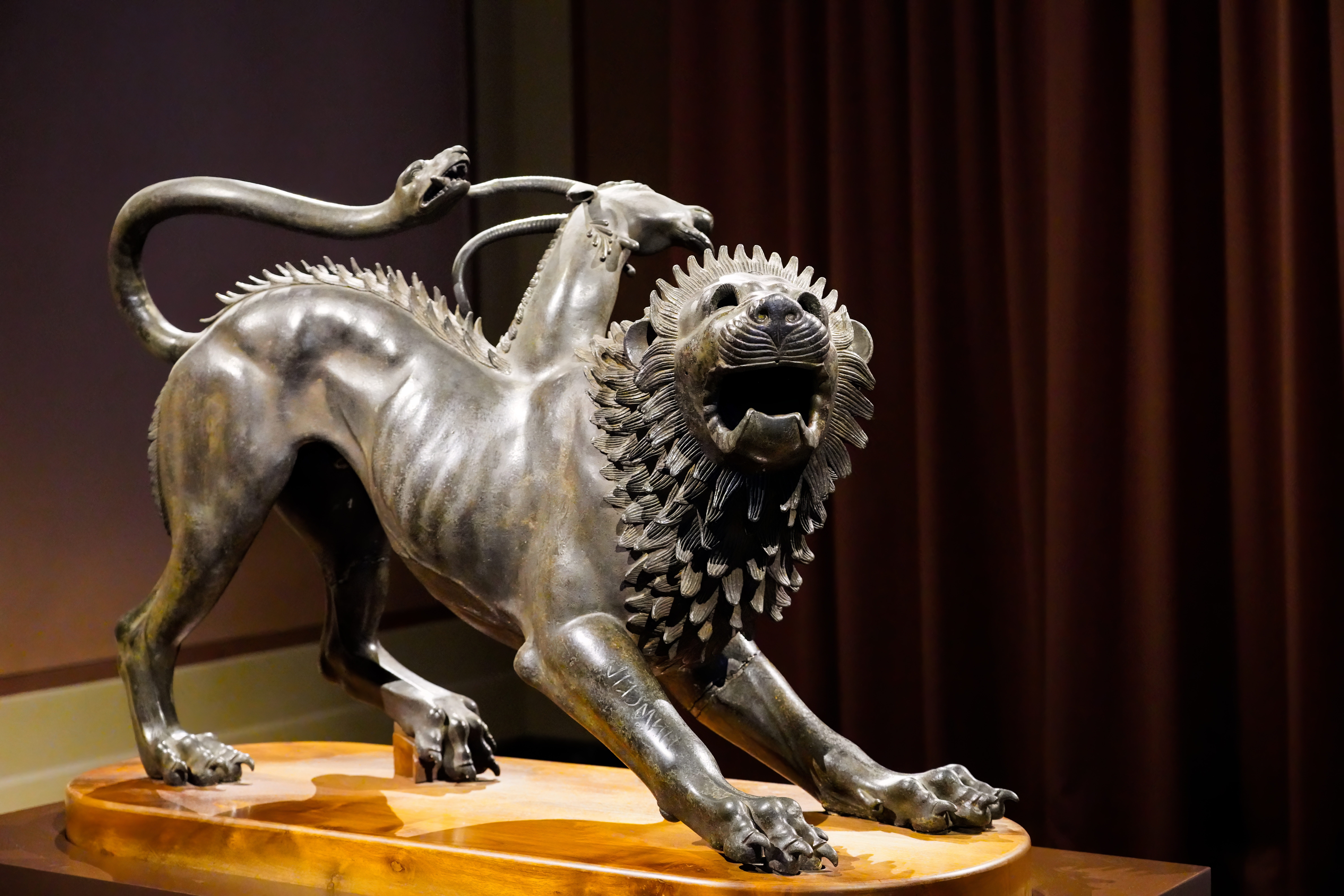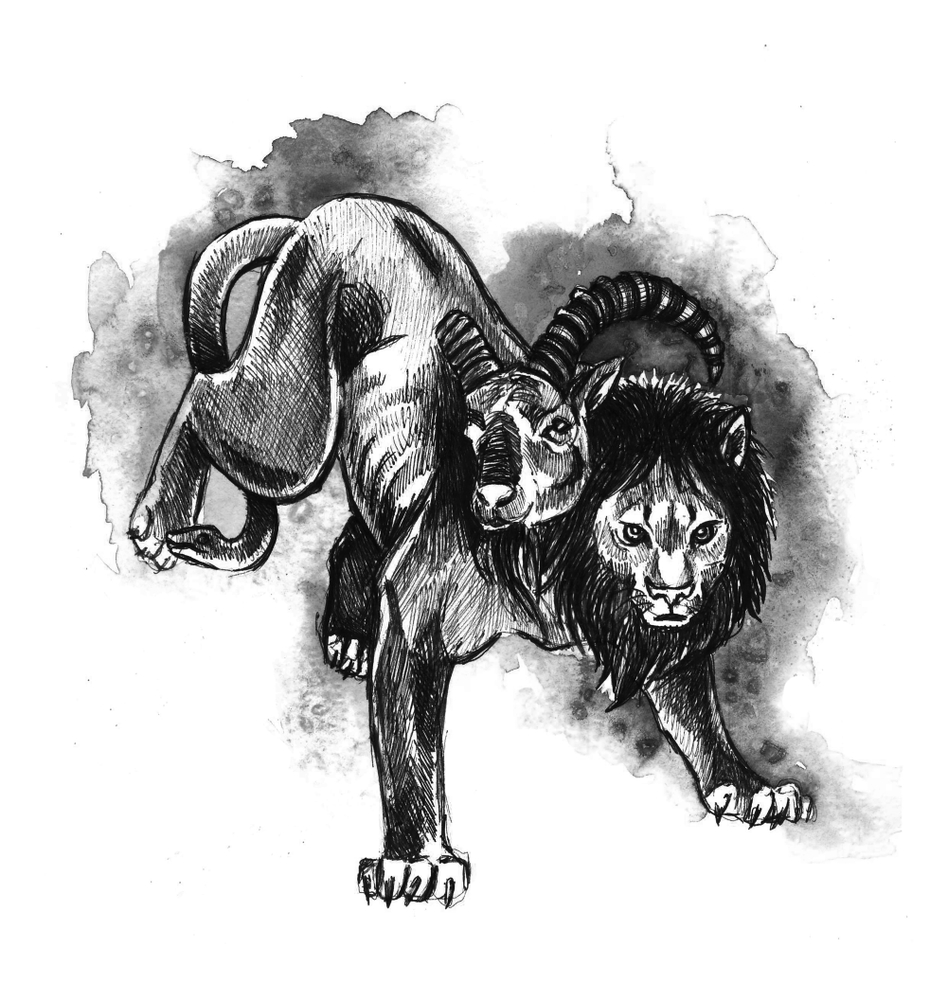Imagine a creature with the head of a lion, the body of a goat, and a tail that ends with the head of a serpent. This terrifying creature is a real figure from Greek mythology known as the chimera.
A fire-breathing beast that blends the features of multiple animals, the chimera captivates anyone interested in the mystical and the mythical. As we delve into the legends and powers of this extraordinary creature, you'll discover why the chimera remains one of the most fascinating subjects in chimerical mythology.
Jump to:
What is a Chimera?

The chimera, or "chimaira," is a term in Greek mythology that refers to a hybrid animal made up of parts from different creatures. Traditionally, it is depicted as a fusion of a lion, a snake, and a goat. It embodies the front part of a lion, the middle of a goat, and the tail ending with a snake's head. This combination makes the chimera a formidable sight, fusing the most fearsome qualities of each animal.
The Chimera’s Myths
The chimera figures prominently in a variety of Greek myths, each illustrating its monstrous nature and the human struggle against overwhelming odds. Descended from the notorious Typhon and Echidna, the chimera shares its lineage with other mythical beasts like Cerberus and the Hydra and embodies the fears and mythical storytelling of ancient Greece.
The Story of the Chimera and Bellerophon
One of the most famous myths about the chimera involves its defeat at the hands of Bellerophon, a tale that showcases the hero's bravery and ingenuity. Tasked with the impossible, Bellerophon used the winged horse Pegasus to soar above the chimera, slaying the beast with a spear from a safe distance. This encounter is often interpreted as a metaphor for overcoming impossible challenges through cleverness and courage.
The Chimera and the Sibyl of Cumae
In another less-known tale, the Sibyl of Cumae, a prophetic priestess, encounters the chimera during one of her visions. Interpreting the chimera’s presence as an omen, the Sibyl advises her followers to seek harmony in their community to ward off the chaos and destruction that the chimera symbolises. This myth highlights the chimera’s connection to disaster and the power of foresight and wisdom in averting such fates.
Homeric Hymns and the Chimera’s Birth
The Homeric Hymns, a collection of ancient Greek hymns, describe the birth of the chimera as an event marked by ominous signs and wonders. These texts describe the earth trembling and the skies darkening at the moment of her birth, setting the tone for the destruction she would later bring into the world. This myth emphasises the unnatural aspects of the chimera’s existence and her predestined role as a creature of disaster.
The Chimera’s Role in the Gigantomachy
Though not a frontline combatant in the Gigantomachy—the legendary battle between the gods and the giants—the chimera is said to have contributed to the chaos of the war. According to some versions of the myth, the gods released the chimera to sow confusion and fear among the giants, leveraging her terrifying appearance and fiery breath. This narrative highlights the strategic use of fear as a weapon in mythical warfare and the chimera’s symbolic association with chaotic elements.
Recommended for you!
Best SellersSymbolism and Representation
The chimera, a composite creature from Greek mythology, is a powerful symbol of chaos. It defies the natural order and instils a blend of fear and awe in those who hear its tales.
What Does the Chimera Represent?
The symbolism of the chimera is rich and varied, reflecting its complex nature:
- Chaos and Disorder: The chimera’s hybrid body symbolises chaos and the disruption of the natural order, much like the unexpected and frightening events that can upend life.
- Fear and Danger: The chimera's ability to breathe fire and its fearsome appearance make it a symbol of danger and the fear of the unknown or unnatural.
- Hybridity and Diversity: Representing a blend of different animals, the chimera symbolises the combination of multiple traits or ideas into a single entity, often with unexpected results.
- Protection from Evil: Despite its fearsome reputation, depictions of the chimera on shields and armour in antiquity suggest it was also considered a protective symbol, guarding against evil and disaster.
Powers and Attributes of the Chimera

The chimera’s legendary powers and vulnerabilities reveal much about its role in Greek mythology. This section explores this hybrid beast's formidable abilities and inherent weaknesses.
What are the Powers of a Chimera?
The chimera’s powers diverse as its physical form. Its ability to breathe fire is inherited from its father, Typhon, a draconic figure associated with winds and storms. This fire-breathing capability allows the chimera to engage in combat from a distance, destroying foes and structures alike with bursts of flame.
Beyond fire, the chimera’s strength and agility stem from its lion’s body, enabling it to dominate in physical confrontations. Additionally, the snake part of its tail may have been capable of injecting venom, adding a lethal edge to its attacks.
What are the Chimera's Weaknesses?
Despite these impressive powers, the chimera possesses significant vulnerabilities:
- Hybrid Vulnerabilities: The chimera’s strength is also its downfall; the disparate nature of its body means it lacks the unified functionality of a single-species organism. For instance, the goat section could potentially be less robust than the lion, offering a strategic weakness for opponents.
- Dependence on Fire: Relying heavily on its ability to breathe fire, the chimera might be at a disadvantage in environments where this ability is neutralised, such as in heavy rain or confined spaces that do not allow for the spread of flames.
- Mythical Heroism: As typical in Greek myths, the chimera’s destiny is intertwined with that of heroes destined to defeat it. The gods often equipped such heroes with divine weapons or guidance, specifically tailored to exploit the chimera’s weaknesses. This was seen in the case of Bellerophon, who attacked from above, a position that the chimera was ill-equipped to defend against.
Chimera vs Other Mythical Creatures

Differences Between a Chimera, a Manticore, and a Griffin
While all these creatures are chimeric, composed of parts of different animals, each has unique attributes. A manticore has a human head, a lion's body, and a scorpion's tail. In contrast, a griffin combines the body of a lion and the wings and head of an eagle. The chimera's distinct combination of lion, goat, and snake parts sets her apart in the mythological zoo.
Is the Sphinx a Chimera?
The sphinx, another mythical creature, shares a chimeric nature but differs significantly from the chimera. Typically, a sphinx has a human head, a lion's body, and is known for its role in riddles and guardianship, unlike the purely destructive role of the chimera.
Chimaeras in Real Life
In modern times, the term "chimera" has transcended its mythological origins to describe real-life genetic chimeras. In biology, a chimera refers to an organism that contains cells from two different organisms. This fascinating scientific phenomenon draws a direct line from ancient myths to contemporary science, showing how these stories continue to influence and inspire our understanding of the world.
Frequently Asked Questions About Chimaeras
Why is the Chimera Considered Evil?
Traditionally, the chimera is considered evil because of her destructive powers and her origin from a lineage of monsters. This representation echoes the ancient Greeks' fear of the unknown and the unnatural.
Who Killed the Chimera in Greek Mythology?
In Greek mythology, the hero who killed the chimera was Bellerophon, who had the help of the winged horse Pegasus. Using a spear while flying on Pegasus, Bellerophon defeated the chimera from a safe distance, showcasing his bravery and tactical intelligence.
What is the Moral of the Story of the Chimera?
The moral of the story involving the chimera often revolves around overcoming fear and facing seemingly impossible challenges. Bellerophon’s victory over the chimera represents courage and the idea that with the right tools and allies, you can overcome great obstacles.
Can a Human Be a Chimera?
In biological terms, a human can indeed be a chimera. This refers to a person having two or more different sets of DNA, usually as a result of being composed of cells from different zygotes. This can occur naturally, for example, through the fusion of fraternal twins in the womb, or artificially, through medical interventions like bone marrow transplantation.
What is the Difference Between a Chimera and a Manticore?
While both are mythical creatures made up of parts of different animals, the chimera and manticore have distinct origins and descriptions. A manticore primarily features a human head, the body of a lion, and a tail that is a venomous spiky weapon, contrasting with the chimera's lion, goat, and snake combination.
What Does a Chimera Look Like in Real Life?
While the mythical chimera does not exist in real life, the term is used in genetics to describe an organism that has cells from two or more different species, which can sometimes result in visible differences. In nature, however, there are no real creatures that resemble the mythological chimera.
Why are Chimeras Controversial?
In modern science, chimeras can be controversial due to ethical concerns surrounding genetic manipulation and the consequences of blending human and animal DNA. These debates often focus on the implications for medical research and the potential impacts on natural evolution and animal welfare.
Is Cerberus a Chimera?
Cerberus, the famed guardian of the underworld in Greek mythology, is not a chimera but another type of mythological creature. Known for having multiple heads (usually three), Cerberus is part of the same monstrous family, being a sibling to the chimera, but does not share the hybrid animal composition of the chimera.
What Do Chimeras Eat?
In mythology, chimeras are often depicted as carnivorous and capable of devouring livestock and humans alike. However, as mythical creatures, their diet is part of the legend rather than based on reality.
How Did the Chimera Get Its Name?
The name "chimera" comes from Greek mythology and has been associated with hybridity and the monstrous. Over time, it has come to symbolise any mythical or fictional animal composed of parts of various creatures, as well as real-life genetic anomalies.
Recommended for you!
Best SellersStudy Greek Mythology With Centre of Excellence
If you're intrigued by the stories of chimeras and other mythical creatures, why not delve deeper into this fascinating subject? Our Greek Mythology Diploma Course at Centre of Excellence provides you with comprehensive insights into these ancient tales.
Why Centre of Excellence?
- Accessibility: We believe that learning should be accessible to everyone, which is why we ensure that our courses are priced to welcome all interested learners.
- Flexibility: Our courses are designed to fit your schedule, allowing you to learn at your own pace and seamlessly integrate your studies into your daily life.
- Wide-ranging Topics: Our curriculum dives deep into the ancient narratives of Greek mythology, offering insights into its complex characters and themes, catering to all who are fascinated by these age-old tales.
- Unwavering Support: Enrolment includes access to personalised tutor support and a community of fellow mythology enthusiasts, providing a supportive learning environment every step of your journey.
Special Offer
We are excited to offer our Greek Mythology Diploma Course at a special discounted price of £29, saving you over £100!













